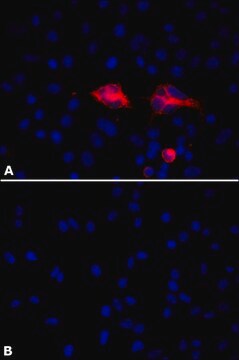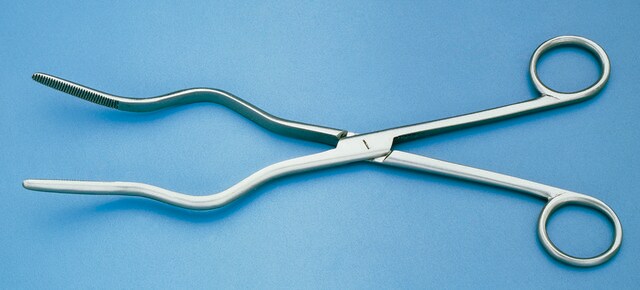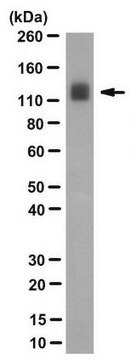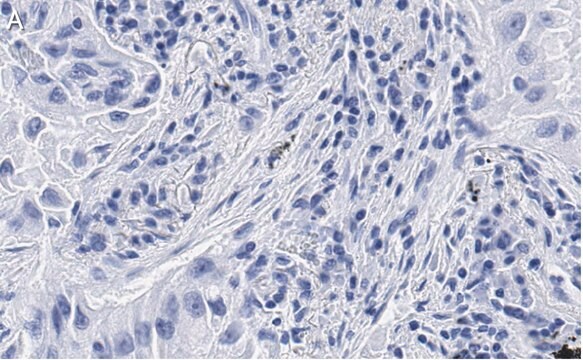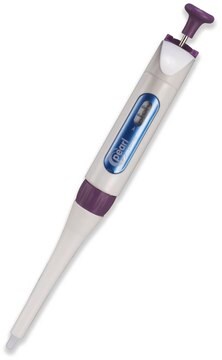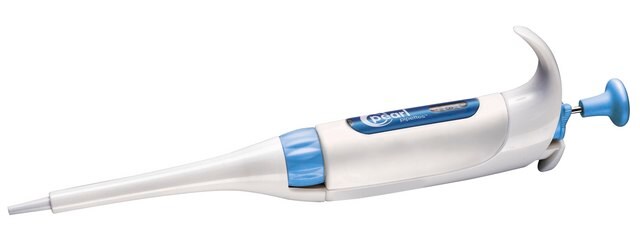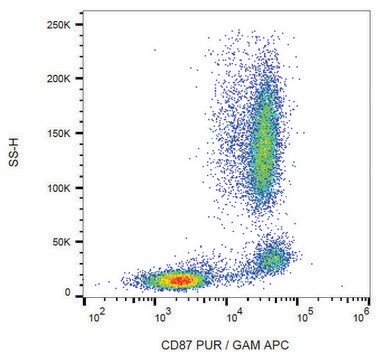推荐产品
生物源
mouse
抗體表格
purified immunoglobulin
抗體產品種類
primary antibodies
無性繁殖
5D6, monoclonal
物種活性
hamster
包裝
antibody small pack of 25 μg
技術
flow cytometry: suitable
immunocytochemistry: suitable
western blot: suitable
同型
IgG1κ
NCBI登錄號
UniProt登錄號
目標翻譯後修改
unmodified
基因資訊
hamster ... Plaur(100689422)
一般說明
Urokinase plasminogen activator surface receptor (UniProt: Q9R119; also known as uPAR) is encoded by the Upar gene (Gene ID: 100689422) in Chinese hamster. uPAR is a GPI-anchored cell membrane receptor for urokinase plasminogen activator (uPA), an enzyme responsible for the activation of plasmin and degradation of extracellular matrix components. Higher expression of uPAR has been reported in many human cancers, including non-small cell lung cancer and colorectal cancer. Its higher levels correlate with poor prognosis and early invasion and metastasis. uPAR is synthesized with a signal peptide (aa 1-18), which is subsequently cleaved off to generate the mature form, which contains three homologus domains (DI, DII, and DIII). uPAR is also reported to serve as an adhesion receptor for vitronectin and a direct interaction between uPAR and vitronectin is shown to be important for inducing changes in cell morphology, cell migration, and signaling. Blocking of uPAR activity can impair cell adhesion and migration in RAS mutated cancer cells. (Ref.: Di Mauro, C et al. (2017). Scientific Reports 7, Article number: 9388).
特異性
Clone 5D6 detects urokinase plasminogen activator surface receptor. It targets an epitope with in the extracellular domain.
免疫原
Epitope: extracellular domain
Raft fraction of the plasma membrane from Chinese hamster ovary (CHO) cells.
應用
Anti-uPAR (CD87), clone 5D6, Cat. No. MABC1099, is a mouse monoclonal antibody that detects Urokinase plasminogen activator surface receptor and has been tested for use in Flow Cytometry, Immunocytochemistry, and Western Blotting.
Research Category
Apoptosis & Cancer
Apoptosis & Cancer
Western Blotting Analysis: A representative lot detected uPAR (CD87) in Western Blotting applications (Maeda, Y., et. al. (2007). Mol Biol Cell. 18(4):1497-506; Lee, G.H., et. al. (2016). J Cell Biol. 215(5):705-718; Hirata, T., et. al. (2018). Nat Commun. 9(1):405).
Flow Cytometry Analysis: A representative lot detected uPAR (CD87) in Flow Cytometry applications (Ashida, H., et. al. (2006). J Biol Chem. 281(2):896-904; Lee, G.H., et. al. (2016). J Cell Biol. 215(5):705-718; Hirata, T., et. al. (2018). Nat Commun. 9(1):405; Hirata, T., et. al. (2013). J Biochem. 154(3):257-64).
Immunocytochemistry Analysis: A representative lot detected uPAR (CD87) in Immunocytochemistry applications (Kanzawa, N., et. al. (2012). J Lipid Res. 53(4):653-63).
Flow Cytometry Analysis: A representative lot detected uPAR (CD87) in Flow Cytometry applications (Ashida, H., et. al. (2006). J Biol Chem. 281(2):896-904; Lee, G.H., et. al. (2016). J Cell Biol. 215(5):705-718; Hirata, T., et. al. (2018). Nat Commun. 9(1):405; Hirata, T., et. al. (2013). J Biochem. 154(3):257-64).
Immunocytochemistry Analysis: A representative lot detected uPAR (CD87) in Immunocytochemistry applications (Kanzawa, N., et. al. (2012). J Lipid Res. 53(4):653-63).
品質
Evaluated by Flow Cytometry in Chinese hamster ovary (CHO) cells.
Flow Cytometry Analysis: 1 µg of this antibody detected uPAR (CD87) in one million Chinese hamster ovary (CHO) cells.
Flow Cytometry Analysis: 1 µg of this antibody detected uPAR (CD87) in one million Chinese hamster ovary (CHO) cells.
標靶描述
35.10 Da calculated.
外觀
Protein G purified
Format: Purified
Purified mouse monoclonal antibody IgG1 in buffer containing 0.1 M Tris-Glycine (pH 7.4), 150 mM NaCl with 0.05% sodium azide.
儲存和穩定性
Stable for 1 year at 2-8°C from date of receipt.
其他說明
Concentration: Please refer to lot specific datasheet.
免責聲明
Unless otherwise stated in our catalog or other company documentation accompanying the product(s), our products are intended for research use only and are not to be used for any other purpose, which includes but is not limited to, unauthorized commercial uses, in vitro diagnostic uses, ex vivo or in vivo therapeutic uses or any type of consumption or application to humans or animals.
未找到合适的产品?
试试我们的产品选型工具.
我们的科学家团队拥有各种研究领域经验,包括生命科学、材料科学、化学合成、色谱、分析及许多其他领域.
联系技术服务部门